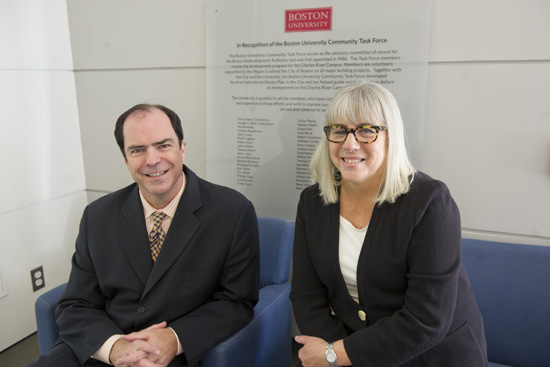BU Community Task Force Celebrates 25th Anniversary
Members helped University grow bigger and better

Joe Walsh, the executive director of community relations (left), and Pamela Beale, chairperson of the BU Community Task Force, in front of a plaque in FitRec recognizing the task force’s 25th anniversary. Photo by Cydney Scott
It’s fitting that a plaque now hangs in the FitRec Center recognizing the four dozen individuals who have served on the Boston University Community Task Force since its founding in 1986. After all, members of the task force helped make the John Hancock Student Village, of which FitRec is a part, possible.
“They were very influential in the planning of that whole development,” says Robert Donahue, associate vice president for government and community affairs. “They wanted housing and activities that would keep the students from wandering around the GAP, Gardner, Ashford, and Pratt Streets. And FitRec represented that.”
This year marks the task force’s 25th anniversary working with the University on its master plan, a document BU drafts to identify its development plans for the coming decade. Boston mayor Raymond Flynn, who was in office from 1984 to 1993, called for the creation of community task forces to serve as advisory groups to the Boston Redevelopment Authority, which ultimately approves or denies zoning for proposed projects within city limits.
BU was the first among its peer institutions to form such a task force. Its 15 volunteer members include residents and business owners from Kenmore Square, Audubon Circle, Bay State Road, Allston, and Brighton and are appointed by the mayor. A BU off-campus student, appointed by the dean of students on a rotating basis, also serves on the committee.
With the task force’s approval, $1 billion worth of development has sprung up across Charles River Campus. Sargent College, the School of Management building, and the new East Campus Center for Student Services, at 100 Bay State Road, now in the early stages of construction, were all projects members signed off on, as was the acquisition of multiple Kenmore Square and Bay State Road properties. Whenever a new project emerges that wasn’t in the master plan, as with the Photonics Center, task force members must review and approve the proposal before it can move forward.
Since the task force’s creation, BU has presented three master plans to the city. “We’ve never had a plan rejected,” Donahue says with pride. (Unlike some neighbors—ahem, Boston College.)
But that doesn’t mean that the task force is merely a rubber stamp. “What people don’t understand is that we work so hard to come to consensus,” says task force chairperson and local businesswoman Pamela Beale, who has served as a member for more than two decades.
Consensus was hard to come by in the group’s early years. Donahue remembers a time when neighbors routinely came to public meetings and dumped trash around the room to dramatize the way they felt students treated their front stoops on weekends.
“We don’t have that anymore,” Donahue says. He gives much of the credit to Joseph Walsh, executive director of community relations, who he says helped smooth tensions with the community and made sure students understood their neighborly responsibilities. Donahue notes that “there are fewer students in the neighborhood than before because there is more housing on campus.” Since the task force was created, he says, BU has boosted the percentage of students it can house from 50 to 77 percent.
Task force members regularly grapple with what impact a new development will have on public transportation, how it will blend with the rest of the neighborhood, and how it can be sustainably built. BU is quick to respond to their concerns.
“The University has elevated the process,” says Beale, owner of Cornwall’s Pub and president of the Kenmore Association. “It brings to meetings all appropriate people from the University and all the consultants. We get to ask pertinent questions and get the answers. It’s not a lot of dancing around or trying to avoid tough questions.”
That’s because, as Walsh says, the task force has the last right of refusal on development plans. “The University doesn’t try to slip anything past them,” he says. “They’re too sharp for that.”
The task force is currently reviewing the University’s fourth master plan. New projects include moving the Admissions Reception Center from 121 Bay State Road to 233 Bay State Road, the former Hillel House, building a lacrosse and field hockey arena over the Babcock Street parking lot, and renovating the School of Law. The first two projects could be completed as early as fall 2013. Down the line, the University would also like to develop a research or academic building on what is now a parking lot directly across from Warren Towers.
Donahue says the University is grateful to task force members for their dedicated service in helping BU grow responsibly: “We couldn’t do it without them.”
Comments & Discussion
Boston University moderates comments to facilitate an informed, substantive, civil conversation. Abusive, profane, self-promotional, misleading, incoherent or off-topic comments will be rejected. Moderators are staffed during regular business hours (EST) and can only accept comments written in English. Statistics or facts must include a citation or a link to the citation.